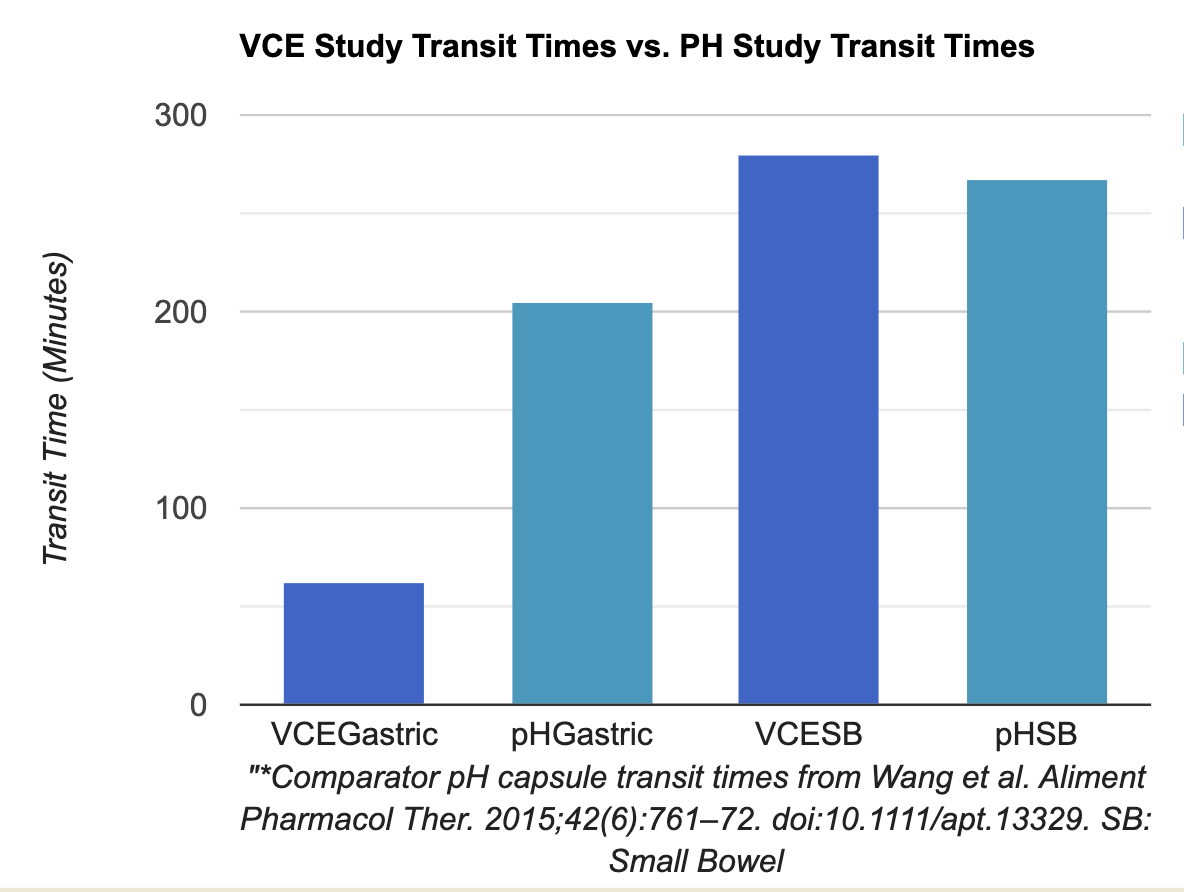Sunday Poster Session
Category: Functional Bowel Disease
P0803 - Defining Normal Gastrointestinal Transit for Video Capsule Endoscopy: A Metric Whose Time Has Come?
Sunday, October 26, 2025
3:30 PM - 7:00 PM PDT
Location: Exhibit Hall

Benjamin M. Berg
Touro University of California
Vallejo, CA
Presenting Author(s)
Benjamin M. Berg, 1, Russell Hollis, MD, MBA2, Noah Storch, 3, Sumera M. Ahmed, MD, BC-ADM1, Ian Storch, DO, FACG4
1Touro University of California, Vallejo, CA; 2North Shore University Hospital - Northwell Health, Manhasset, NY; 3Syosset High School, Woodbury, NY; 4Gastroenterology Consultants of Long Island, Woodbury, NY
Introduction: Evaluating GI tract transit times are essential to assess diseases related to motility. Scintigraphy and sitz mark studies are often recommended, but require a specialized center. PH-related capsules have been developed but are not readily available and require special equipment. Transit times are included in standard VCE reports and small studies have suggested that VCE transit times may be relevant, however, normal values have not been defined in a large cohort. This study aims to define normal gastrointestinal transit times measured by standard VCE.
Methods: In this IRB approved study, 197 sequential capsule endoscopy procedures performed in a private practice with the Capsocam system from 2018-2025 were retrospectively reviewed. Patients had capsule endoscopy performed for gastrointestinal (GI) bleeding (overt or obscure) or for suspicion of IBD. A 4 L peg prep and overnight fast was used prior to the procedure. The primary outcomes were gastric, small bowel transit times. De-identified data were analyzed with ChatGPT to obtain mean and standard deviation by an unpaired t-test and compared to pH-based capsule transit times from previously published data. A p value less than 0.05 was considered significant.
Results: 195 VCE studies were evaluated for gastric and small bowel transit times. VCE studies which did not leave the stomach were excluded (n=2). Mean gastric transit time of the VCE capsule was significantly shorter than pH-based capsules (p=.0001). There was no statistically significant difference in small bowel transit transit time(Figure 1). Colonic transit time, which was reported for the pH capsule, could not be obtained for our VCE studies as none of the capsules completely passed through the colon.
Discussion: Our study defines normal times for gastric and small bowel transit for VCE. Gastric emptying time is shorter than wth pH-based capsules likely due standard fasting prior to VCE, while the pH-based capsule requires a meal protocol. It is interesting, however, that mean gastric emptying for VCE is longer than expected for liquids (20-30 min), which may suggest a mechanism similar to solids. We suggest further study to determine if VCE gastric emptying times can provide pertinent information regarding gastroparesis. Small bowel times outside of the 95% confidence interval may be used to help assess functional bowel disease. Further, a VCE capsule developed with longer battery life or decreased frame rate might allow calculation of colonic transit time.

Figure: VCE Study Transit Times vs. PH Study Transit Times

Figure: TABLE: Evaluation of VCE transit times and comparison to pH Capsule transit
Disclosures:
Benjamin Berg indicated no relevant financial relationships.
Russell Hollis indicated no relevant financial relationships.
Noah Storch indicated no relevant financial relationships.
Sumera Ahmed indicated no relevant financial relationships.
Ian Storch: CasoVision Inc. – Consultant, Owner/Ownership Interest.
Benjamin M. Berg, 1, Russell Hollis, MD, MBA2, Noah Storch, 3, Sumera M. Ahmed, MD, BC-ADM1, Ian Storch, DO, FACG4. P0803 - Defining Normal Gastrointestinal Transit for Video Capsule Endoscopy: A Metric Whose Time Has Come?, ACG 2025 Annual Scientific Meeting Abstracts. Phoenix, AZ: American College of Gastroenterology.
1Touro University of California, Vallejo, CA; 2North Shore University Hospital - Northwell Health, Manhasset, NY; 3Syosset High School, Woodbury, NY; 4Gastroenterology Consultants of Long Island, Woodbury, NY
Introduction: Evaluating GI tract transit times are essential to assess diseases related to motility. Scintigraphy and sitz mark studies are often recommended, but require a specialized center. PH-related capsules have been developed but are not readily available and require special equipment. Transit times are included in standard VCE reports and small studies have suggested that VCE transit times may be relevant, however, normal values have not been defined in a large cohort. This study aims to define normal gastrointestinal transit times measured by standard VCE.
Methods: In this IRB approved study, 197 sequential capsule endoscopy procedures performed in a private practice with the Capsocam system from 2018-2025 were retrospectively reviewed. Patients had capsule endoscopy performed for gastrointestinal (GI) bleeding (overt or obscure) or for suspicion of IBD. A 4 L peg prep and overnight fast was used prior to the procedure. The primary outcomes were gastric, small bowel transit times. De-identified data were analyzed with ChatGPT to obtain mean and standard deviation by an unpaired t-test and compared to pH-based capsule transit times from previously published data. A p value less than 0.05 was considered significant.
Results: 195 VCE studies were evaluated for gastric and small bowel transit times. VCE studies which did not leave the stomach were excluded (n=2). Mean gastric transit time of the VCE capsule was significantly shorter than pH-based capsules (p=.0001). There was no statistically significant difference in small bowel transit transit time(Figure 1). Colonic transit time, which was reported for the pH capsule, could not be obtained for our VCE studies as none of the capsules completely passed through the colon.
Discussion: Our study defines normal times for gastric and small bowel transit for VCE. Gastric emptying time is shorter than wth pH-based capsules likely due standard fasting prior to VCE, while the pH-based capsule requires a meal protocol. It is interesting, however, that mean gastric emptying for VCE is longer than expected for liquids (20-30 min), which may suggest a mechanism similar to solids. We suggest further study to determine if VCE gastric emptying times can provide pertinent information regarding gastroparesis. Small bowel times outside of the 95% confidence interval may be used to help assess functional bowel disease. Further, a VCE capsule developed with longer battery life or decreased frame rate might allow calculation of colonic transit time.

Figure: VCE Study Transit Times vs. PH Study Transit Times

Figure: TABLE: Evaluation of VCE transit times and comparison to pH Capsule transit
Disclosures:
Benjamin Berg indicated no relevant financial relationships.
Russell Hollis indicated no relevant financial relationships.
Noah Storch indicated no relevant financial relationships.
Sumera Ahmed indicated no relevant financial relationships.
Ian Storch: CasoVision Inc. – Consultant, Owner/Ownership Interest.
Benjamin M. Berg, 1, Russell Hollis, MD, MBA2, Noah Storch, 3, Sumera M. Ahmed, MD, BC-ADM1, Ian Storch, DO, FACG4. P0803 - Defining Normal Gastrointestinal Transit for Video Capsule Endoscopy: A Metric Whose Time Has Come?, ACG 2025 Annual Scientific Meeting Abstracts. Phoenix, AZ: American College of Gastroenterology.
